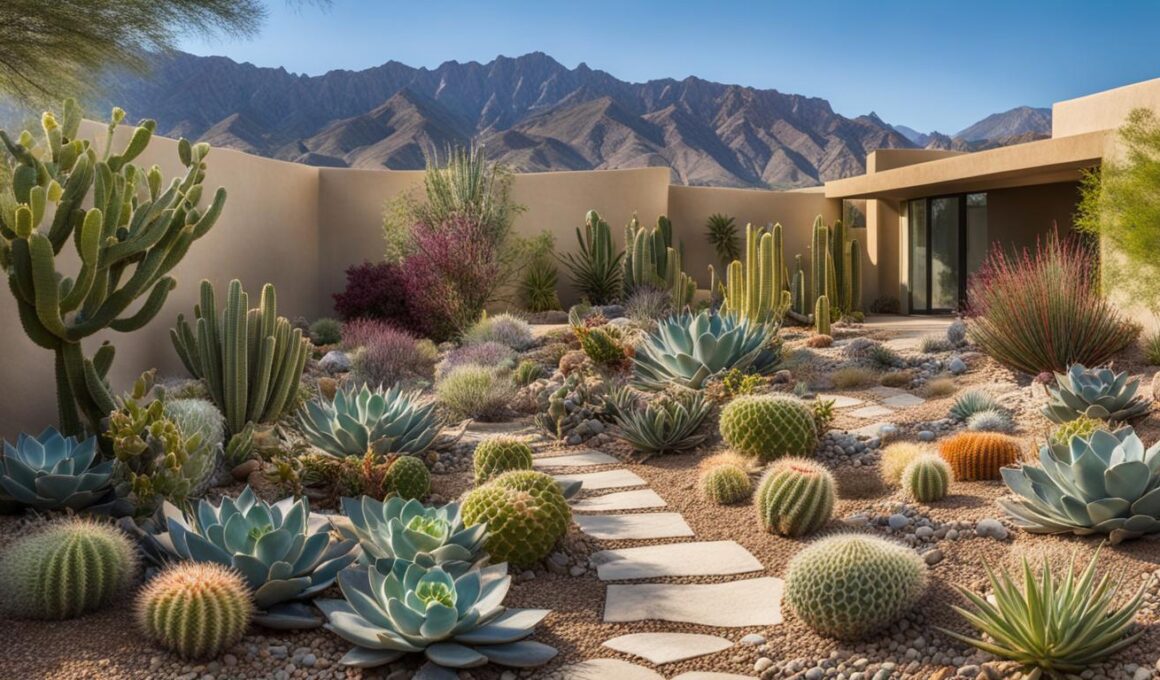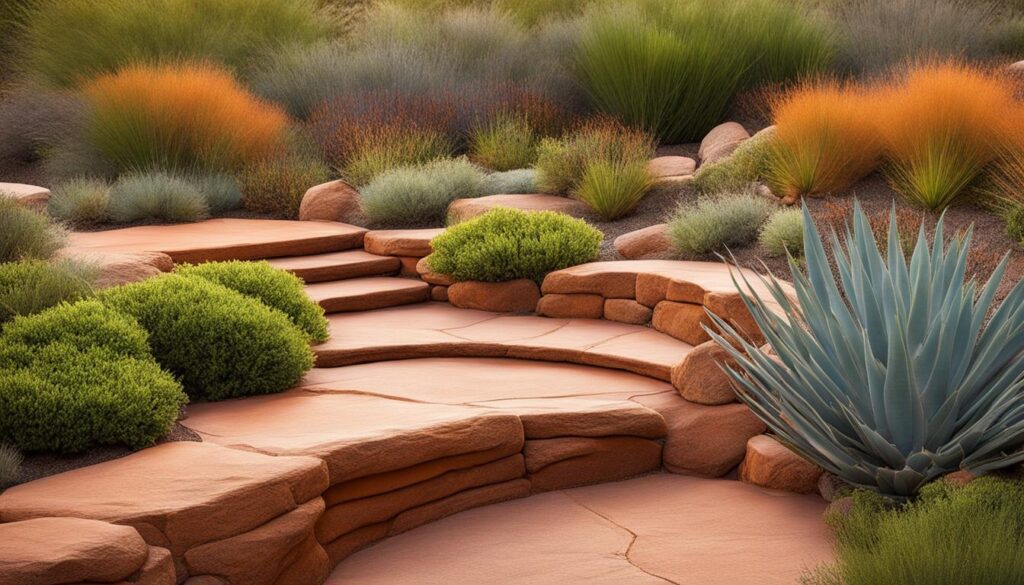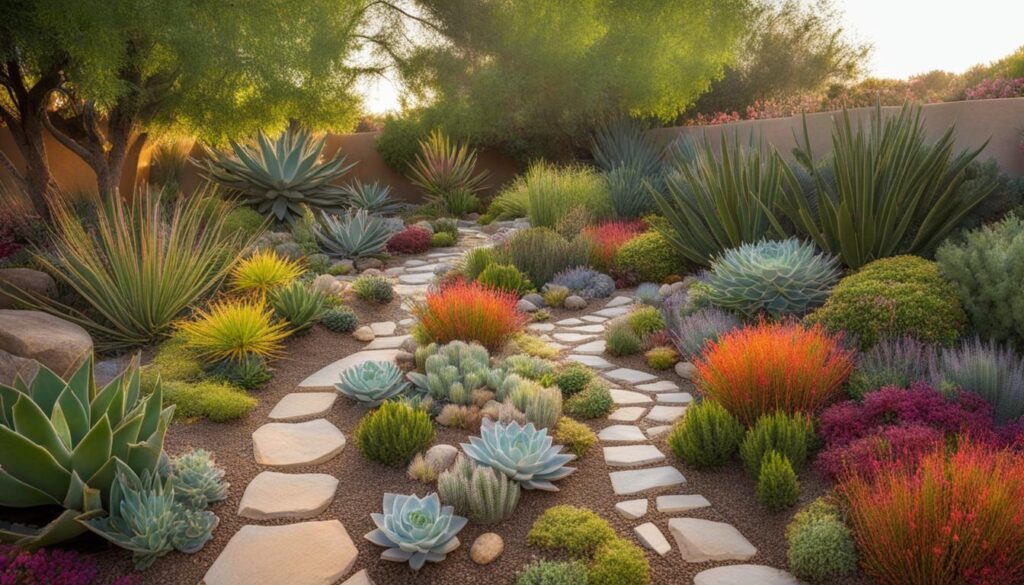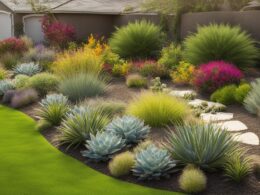Xeriscaping is a type of landscape design that uses low-water-use or drought-tolerant plants. It is an ideal solution for creating water-wise yards and gardens. In this article, we will explore stunning xeriscape garden designs that can be implemented in any home. By incorporating these designs, you can save water, time, and effort while still enjoying a beautiful and vibrant outdoor space.
Key Takeaways:
- Low-water xeriscape designs can help conserve water while creating beautiful outdoor spaces.
- Design principles, such as selecting companion plants and choosing climate-adapted plants, are crucial for successful xeriscape gardens.
- There are various plant combinations that thrive in low-water conditions, including those for full sun areas, pathways, borders, and open spaces.
- Xeriscape gardens enhance the beauty and sustainability of your home’s landscape.
- Implementing xeriscape designs can save water, time, and effort in maintaining a vibrant outdoor space.
Design Principles for a Successful Low-Water Xeriscape Garden
When it comes to designing a low-water xeriscape garden, there are several key principles to consider. By following these principles, you can create a stunning garden that not only conserves water but also thrives in its environment.
Firstly, it’s important to select companion plants with similar light, water, and soil needs. This ensures that all the plants in your garden are compatible and will thrive together. By grouping plants with similar requirements, you can create a harmonious and balanced ecosystem that is easier to maintain.
Secondly, blending plant characteristics such as shape, size, texture, and color is crucial for creating an aesthetically pleasing garden. By incorporating a variety of plant forms and colors, you can add visual interest and create a beautiful tapestry of foliage and blooms. Consider using plants with different leaf textures, heights, and flowering times to create a dynamic and ever-changing landscape.
Lastly, selecting plants that are well-suited to your climate zone and site conditions is essential for the success of your xeriscape garden. Choose plants that are adapted to your region’s rainfall patterns, temperature range, and soil type. By selecting climate-appropriate plants, you can ensure that your garden thrives with minimal water usage and maintenance.
“By following these design principles, you can create a successful low-water xeriscape garden that not only looks beautiful but also thrives in its environment.”
Design Principles Recap:
- Select companion plants with similar light, water, and soil needs.
- Blend plant characteristics like shape, size, texture, and color.
- Choose plants that thrive in your climate zone and site conditions.
By following these design principles, you can create a low-water xeriscape garden that is not only visually appealing but also sustainable and environmentally friendly. Your garden will be a haven for drought-tolerant plants, providing habitat for beneficial insects and wildlife, while reducing water consumption and maintenance efforts.
Next, we will explore stunning xeriscape combinations that thrive in full sun areas, allowing you to create a vibrant and water-efficient garden that can withstand the intense heat of the sun.
Stunning Xeriscape Combinations for Full Sun Areas
Designing a xeriscape garden in full sun areas can be a challenge, but with the right plant combinations, you can create a stunning and water-wise landscape. Here are some beautiful xeriscape combinations that thrive in full sun:
Dramatic Statement:
Create a bold and dramatic statement with a combination of ‘Blue Glow’ agave, ‘Golden Tip’ conebush, narrow-leaf chalksticks, and ‘Mesa Wine’ sunrose. These plants feature spiky foliage and contrasting colors, adding interest and vibrancy to your garden. Not only are they visually striking, but they also have low water needs, making them perfect for full sun areas.
Colorful Tapestry:
Add a tapestry of color to your pathways with a combination of sea thrift, silver carpet, fortnight lily, and lavender. These plants offer a stunning display of pastel flowers and silvery ground cover, creating a beautiful contrast against the dark Mexican pebbles. They are well-suited for various climate zones and require minimal watering, making them ideal choices for xeriscape designs.
By incorporating these stunning xeriscape combinations into your full sun areas, you can create a visually appealing and water-wise garden that thrives in even the hottest conditions. Remember to consider the specific light, water, and soil needs of each plant when designing your xeriscape garden.
Creating a xeriscape garden not only reduces water usage but also enhances the beauty and sustainability of your outdoor space. Stay tuned for the next section, where we will explore how xeriscape plants can create a stunning tapestry of color along pathways.
Xeriscape Plants: Enhancing Pathways with Water-Wise Beauty
When it comes to creating a visually appealing and water-wise landscape, incorporating xeriscape plants along pathways is a winning choice. These plants not only add vibrant colors and textures but also require minimal watering, making them perfect for conserving water while enhancing the beauty of your outdoor space.
One stunning combination of xeriscape plants for pathways includes sea thrift, silver carpet, fortnight lily, and lavender. Sea thrift, with its delicate pink flowers, creates a charming and whimsical touch along the pathway. Silver carpet, a low-growing ground cover with soft, silvery foliage, adds a touch of elegance and beauty. Fortnight lily showcases lovely clusters of vibrant purple flowers, while lavender fills the air with its enchanting fragrance. Together, these plants create a tapestry of color that will captivate anyone walking along the path.
Benefits of Using Xeriscape Plants along Pathways
- Water Conservation: Xeriscape plants have low water requirements, reducing the need for frequent watering and conserving water resources.
- Low Maintenance: These plants are typically low maintenance, requiring less time and effort for upkeep.
- Visual Appeal: Xeriscape plants come in a variety of colors, shapes, and textures, adding visual interest and beauty to your pathways.
- Fragrance and Aromatherapy: Certain xeriscape plants, like lavender, release delightful scents, creating a relaxing and soothing atmosphere along your pathways.
“Incorporating xeriscape plants along your pathways not only adds aesthetic value but also reduces water usage, making it a sustainable and eco-friendly landscaping choice.”
Whether you have a small garden path or a sprawling walkway, xeriscape plants can transform these areas into enchanting and water-wise spaces. By carefully selecting plants that thrive in your climate zone and have low water needs, you can create a visually stunning and environmentally friendly pathway that will be the highlight of your outdoor landscape.
Cascading Succulents and Companion Plants for a Stunning Border
Incorporating cascading succulents and companion plants in your xeriscape garden can create a stunning border that adds visual interest and texture to your outdoor space. These plants are not only low-water and low-maintenance but also offer a variety of leaf colors and textures that can enhance the overall beauty of your garden.
A combination of ‘Angelina’ stonecrop, ‘White Swan’ coneflower, and ‘Seascape’ mat rush can be a perfect choice for a stunning border. The ‘Angelina’ stonecrop features vibrant yellow foliage that cascades over walls or edges, creating a unique look. The ‘White Swan’ coneflower adds elegant white flowers with a touch of pink to the mix, attracting butterflies and other pollinators. Lastly, the ‘Seascape’ mat rush offers blue-gray foliage that complements the other plants, creating a harmonious color palette.
Not only do these plants provide visual appeal, but they also serve as excellent companions for one another. The ‘Angelina’ stonecrop and ‘Seascape’ mat rush act as a ground cover, providing a lush base for the ‘White Swan’ coneflower to stand out. This combination adds layers to your border, making it more dynamic and visually captivating.
Create a Beautiful Contrast
When designing a stunning border with cascading succulents and companion plants, it’s important to consider creating a beautiful contrast. For example, you can pair the vibrant green foliage of the ‘Angelina’ stonecrop with dark Mexican pebbles to achieve a striking visual effect. The contrasting colors and textures will draw the eye and create a focal point in your garden.
In conclusion, incorporating cascading succulents and companion plants in your xeriscape garden can elevate the overall aesthetic and create a stunning border. With their low-water needs and beautiful foliage, these plants not only conserve water but also add depth, texture, and visual interest to your outdoor space. Consider implementing a combination like ‘Angelina’ stonecrop, ‘White Swan’ coneflower, and ‘Seascape’ mat rush to create a captivating border that will be the envy of your neighborhood.
How Can I Use Xeriscaping Techniques to Create a Stunning Garden Design?
By incorporating master lowwater garden design techniques, you can create a stunning and sustainable garden. Utilize drought-resistant plants, efficient irrigation systems, and strategic mulching to minimize water usage while producing a beautiful landscape. Xeriscaping principles can result in a vibrant and eco-friendly garden design that thrives in arid climates.
Designing a Harmonious Xeriscape Garden with Grasses and Companions
When it comes to creating a harmonious and sustainable xeriscape garden, incorporating grasses and companion plants can add a touch of natural beauty and serenity. Grasses, known for their graceful sway in the breeze, can provide texture, height, and movement to your landscape. Combined with the right companion plants, you can create a visually stunning and cohesive design that thrives in low-water conditions.
One excellent grass choice for a xeriscape garden is the ‘Karl Foerster’ feather reed grass. With its tall, upright growth habit and feathery plumes, it adds a sense of verticality and elegance to the landscape. The ‘Canyon Prince’ wild rye grass, known for its attractive blue-green foliage and tolerance to drought, complements the ‘Karl Foerster’ grass perfectly. The combination creates a visually appealing contrast and a sense of movement.
To enhance the color scheme and fragrance in your xeriscape garden, consider adding the ‘Provence’ lavandin. This aromatic perennial plant features slender, silvery leaves and beautiful spikes of lavender-blue flowers. It not only adds visual interest but also attracts pollinators to your garden, creating a vibrant and lively ecosystem. The ‘Provence’ lavandin pairs well with the grasses, providing a soft, purple hue and a subtle fragrance that enhances the overall sensory experience of your garden.
Benefits of Grasses and Companions in a Xeriscape Garden:
- Provide texture, height, and movement to the landscape
- Require minimal watering and maintenance
- Create a visually stunning and cohesive design
- Attract pollinators and enhance biodiversity
- Add a sense of serenity and natural beauty
By incorporating grasses and companion plants into your xeriscape garden, you can design a landscape that not only conserves water but also embraces the beauty of nature. The combination of grasses like ‘Karl Foerster’ feather reed grass, ‘Canyon Prince’ wild rye grass, and companion plants like ‘Provence’ lavandin can create a harmonious and visually appealing outdoor space. With their resilience and low-water requirements, these plants are ideal for creating a sustainable and stunning xeriscape garden.
Conclusion
By incorporating low-water xeriscape garden designs, you can create stunning outdoor spaces while conserving water. Design principles such as selecting companion plants, blending plant characteristics, and choosing climate-adapted plants are essential for successful xeriscape designs.
Whether you have full sun areas, pathways, borders, or open spaces, there are various plant combinations that can thrive in low-water conditions. These xeriscape garden designs not only reduce water usage but also enhance the beauty and sustainability of your home’s landscape.
With low-water xeriscape garden designs, you can enjoy a vibrant and lush garden without the need for excessive watering. Implementing these designs will not only save you time and effort but also contribute to a more environmentally friendly and water-wise approach to gardening. Start creating your own low-water xeriscape garden today and transform your outdoor space into a beautiful oasis.














